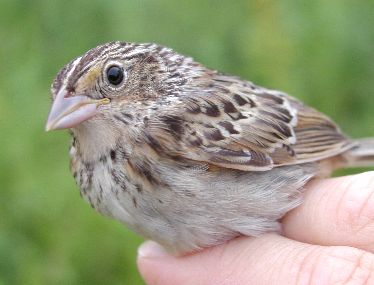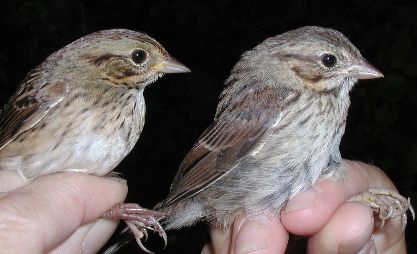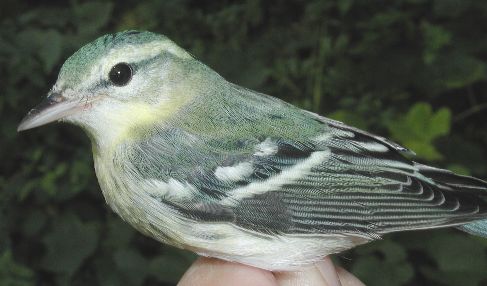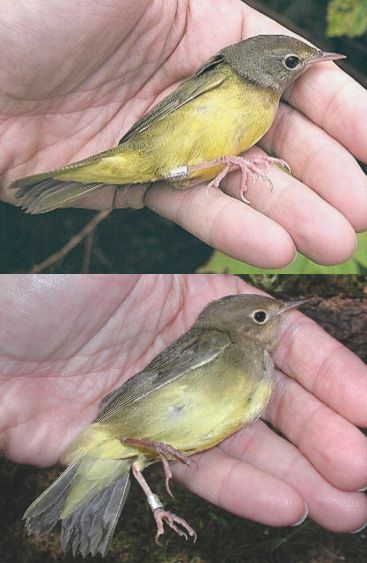
Far and away the most numerous bird this week was Magnolia Warbler (93 banded; maxima of 22 on 8/29 and 21 on 8/30). Numbers of Ruby-throated Hummingbird (48 banded), Common Yellowthroat (46), and Red-eyed Vireo (33) far exceeded last week's totals for these species, and 21 Yellow-bellied Flycatcher this week was just one fewer than the week before. Wood warblers continued to be a big part of our early fall catch--21 species and nearly half of the 631 birds banded were wood warblers. Best represented, after Magnolia and Common Yellowthroat, were Northern Waterthrush (24), American Redstart (22), Hooded Warbler (20), and Chestnut-sided (19).
Banding highlights this week included an immature Grasshopper Sparrow, the season's first Lincoln's Sparrow, an immature male Cerulean Warbler and an immature female Connecticut Warbler (go to photo highlights immediately below the totals table).
| SPECIES | 8/29-9/3 |
| Sharp-shinned Hawk* | 1 |
| American Woodcock* | 2 |
| Ruby-throated Hummingbird | 48 |
| Downy Woodpecker | 3 |
| Northern Flicker | 1 |
| Eastern Wood-Pewee | 5 |
| Yellow-bellied Flycatcher | 21 |
| Acadian Flycatcher | 2 |
| Traill's Flycatcher | 7 |
| Least Flycatcher | 12 |
| Eastern Phoebe | 2 |
| Red-eyed Vireo | 33 |
| Blue Jay | 4 |
| Black-capped Chickadee | 5 |
| Tufted Titmouse | 2 |
| White-breasted Nuthatch | 2 |
| Carolina Wren | 1 |
| House Wren | 2 |
| Golden-crowned Kinglet | 2 |
| Blue-gray Gnatcatcher | 1 |
| Veery | 3 |
| Swainson's Thrush | 5 |
| Wood Thrush | 11 |
| Gray Catbird | 23 |
| Brown Thrasher | 2 |
| Cedar Waxwing | 8 |
| Blue-winged Warbler | 4 |
| Tennessee Warbler | 5 |
| Nashville Warbler | 3 |
| Yellow Warbler | 1 |
| Chestnut-sided Warbler | 19 |
| Magnolia Warbler | 93 |
| Black-throated Blue Warbler | 5 |
| Black-throated Green Warbler | 12 |
| Blackburnian Warbler | 3 |
| Bay-breasted Warbler* | 2 |
| Cerulean Warbler | 1 |
| Black-and-white Warbler | 5 |
| American Redstart | 22 |
| Ovenbird | 17 |
| Northern Waterthrush | 24 |
| Kentucky Warbler | 2 |
| Connecticut Warbler | 1 |
| Mourning Warbler | 5 |
| Common Yellowthroat | 46 |
| Hooded Warbler | 20 |
| Wilson's Warbler | 10 |
| Canada Warbler | 9 |
| Scarlet Tanager | 13 |
| Eastern Towhee | 5 |
| Chipping Sparrow | 1 |
| Field Sparrow | 2 |
| Grasshopper Sparrow* | 1 |
| Song Sparrow | 9 |
| Lincoln's Sparrow* | 1 |
| Rose-breasted Grosbeak | 20 |
| Indigo Bunting | 5 |
| Baltimore Oriole | 4 |
| Purple Finch | 5 |
| House Finch | 9 |
| American Goldfinch | 39 |
| Weekly Banding Total | 631 |
* First fall 2001 banding of the species
Because there is no suitable habitat for them in the vicinity of our net lanes, the capture of any member of the grassland community of songbirds is a highlight at the Powdermill banding station. A Grasshopper Sparrow this week was just our 27th to band in 40 years. The immature bird (pictured below) was still mostly in juvenal plumage, as evidenced by the fine streaking on its breast.

In the photo below, an immature (hatching year; HY) LISP is pictured alongside a juvenile SOSP. Fine streaking and a buffy wash over the streaked sides and breast of the LISP is generally distinctive, but SOSPs in juvenal plumage also show fine streaking and a have a variable yellowish to buffy tinge over their face and underparts. The thinner bill (like a Swamp Sparrow--see comparison photos of SOSP and SWSP from the week of 8/1 ), darker buff submoustachial stripe (the light area directly above the dark malar streak, which is the stripe that extends down from the corner of the bill), and a sharper contrast between the buffy sides and breast and the white chin and belly, serve to distinguish the LISP from juvenile SOSPs. Note, HY LISPs have an olive-gray supercilium (the broad light-colored stripe above the eye), whereas adults (after hatching year; AHY) have a cleaner gray supercilium (a similar difference exists between HY and AHY SWSPs in fall).


Lastly, we caught our second fall Connecticut Warbler (an immature female) this week. Pictures of the bird did not turn out as well as we hoped (in our experience, CONWs are another comparatively unphotogenic species), but we included one for comparison with an immature Mourning Warbler. The MOWA (top photo) shows the characteristic broken eye ring (especially at the front edge), while the CONW (bottom photo) has a complete eye ring. Note also the more extensive grayish olive hood on the CONW, which extends across and farther down along the sides of the breast than the MOWA. CONWs are somewhat larger than MOWAs and have proportionately much longer wings, although this is not particularly evident in our photos. Rest assured, we will keep trying for better photos of CONW this fall!

GO TO>> PAST PICTORIAL HIGHLIGHTS
Last Updated on 9/04/01
By Robert S. Mulvihill